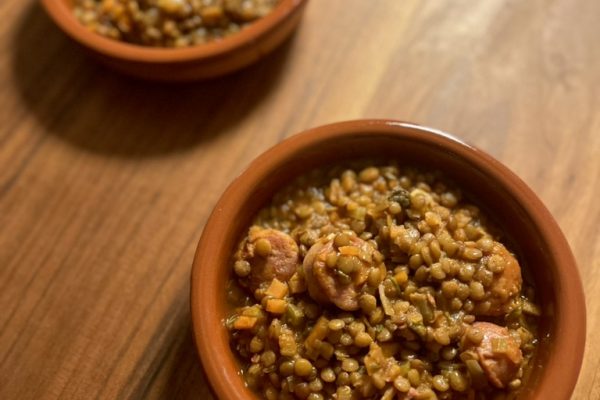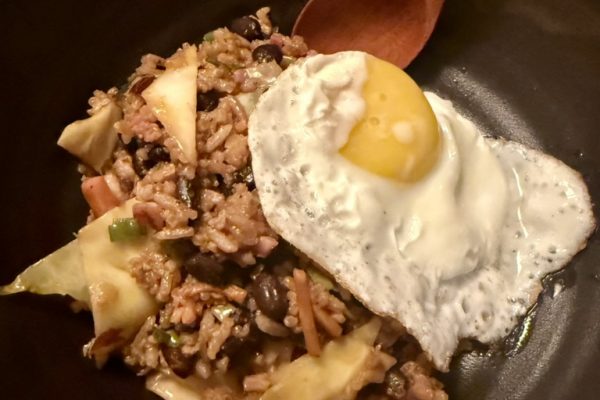The day before: the broth
So now the recipe for our first – vegan – ramen. We start with the broth, for which we cannot use meat, of course, but also no bonito flakes (katsuobushi), which means we lose a typical flavour component. That’s why we use dried shiitake instead of dried bonito, which provides plenty of umami.

In many recipes, konbu is added to the vegetable broth and the whole broth is cooked at once. We don’t do that because then you can’t control the taste of the konbu. Instead, we always make two broths, which we then combine to our liking.
So the day before, we first prepare a dashi by simply putting the konbu and shiitake in cold water and leaving them in a pot with a lid in the fridge overnight.
Also the day before, we make the vegetable broth. This could be done more quickly, but in our way you create much more flavour.

Which vegetables you use in which combination is entirely up to you. Today we choose onions, celery, carrots, leeks, spring onions, fennel and plenty of ginger and garlic. We also add a little potato. You wouldn’t do that for a clear vegetable broth and they don’t add anything to the taste, but their starch gives our broth a stronger texture.
The vegetables only need to be washed, but not peeled. We simply cut the ginger and a whole garlic bulb once in the middle. The rest of the vegetables are cut into coarse pieces.

Then we roast the ginger and garlic briefly on the cut surfaces in our stock pot without adding any oil until both turn dark brown. This happens very quickly, so don’t leave the pot unattended. This method creates more flavour and also gives the broth a nice colour, to which the skins of the onions also contribute a lot.

We then add all the other vegetables and pour cold water over everything.

We bring this to the boil and let the vegetables simmer for at least one and a half hours, but preferably up to three hours. A lid helps to save energy. Important: When cooking broths, no salt is added. We have explained why here.
We simply leave the pot with the vegetable stock on the cooker switched off overnight. This way, the last bit of flavour from the vegetables is transferred to the water. Then we pass the broth through a sieve. It will be cloudy, and it should be.
The next day, the konbu and shiitake are considerably soaked. We remove the shiitake and put the water and konbu on the stove at medium-high heat. Foam will form on top of the water, which we remove with a small sieve or ladle. Just before the boiling point, we take the pot off the cooker and after another 5 minutes we remove the konbu.

With a lot of time, but very little work, we created a basic vegetable broth and a clear dashi.

Now we mix our later ramen broth from these two base broths. A good rule of thumb: two-thirds vegetable broth and one-third dashi – we made our two basic broths in the corresponding amount. However, since we use natural products and different vegetables are used as well, you should always follow your personal taste.
We gently heated our vegetable broth to a temperature that creates a pleasant mouthfeel. Then we added about two-thirds of the dashi and carefully salted it, but only below the level that the finished ramen should have, because salty ingredients are still added to the broth. We were happy with the result when almost all of the dashi, but just not the whole amount, was added to the broth. The remaining dashi can be frozen.

Another trick: A non-vegan broth always contains fat and this is not only a flavour carrier, it also contributes to the texture of a broth. We added a tiny amount of coconut oil to our broth after seasoning. Although the coconut oil is completely tasteless, it rounds off the broth in a great way.
The Tare
Today we want to prepare a Shoyu Ramen. So our very simple Tare is made by gently roasting a few slices of garlic in a little sesame oil….

…and then add light shoyu (Usukuchi), dark shoyu (Koikuchi) and mirin (sweet rice wine). Season with a little white pepper, mix well – done.

The oil
For this ramen, we use our homemade chili oil. It goes great with the sweetness of the shoyu.
The toppings
There are no limits to your creativity here. We have opted for very classic toppings:
Fry the thick stems of pak choi in a hot pan with a little oil. We let the fine leaves stick out over the edge of the pan, they do not need much heat.

When the stems are lightly toasted on both sides, we sprinkle the vegetables with a little light shoyu and a tablespoon of our broth to gently steam them.

We fry oyster mushrooms over medium-high heat for a good 5 minutes until they have lost most of their liquid and add a few dashes of light shoyu at the end as well.

We cut king oyster mushrooms into thick slices, score them diagonally and sauté them on both sides for 6 – 7 minutes before brushing with a little dark shoyu at the very end.

We blanch bean sprouts for two minutes in boiling salted water, then rinse them with cold water and season with a little Japanese chuno sauce, which is made from vegetables and fruits and can be bought ready-made. Alternatively, the sprouts can just be blanched or seasoned in some other way. Everything is allowed.

We also finely chop spring onions and put them in a little water, dry roast some sesame seeds in the pan and portion grains of cooked corn.
The noodles
We cooked bought ramen noodles according to the package instructions. We will soon show how to make these noodles yourself in a separate recipe.
The finale
A ramen is assembled like this:
In a preheated bowl (oven at 50 degrees) we first put some tare, in our case the shoyu mixture. Then we add a little oil, according to taste. This is poured with very hot broth, 400 – 500 ml is needed.
Now the noodles are put into the broth, which is best done with chopsticks. In Japan, the noodles are even arranged nicely.
Finally, the toppings are added. The very hot broth transfers the right temperature to all these ingredients.

We deliberately specify a larger quantity for the ingredients. If you spend the time, then it makes sense to cook more broth right away and use the rest on another day or freeze it.
Enjoy.
And may the taste be with you.
Ingredients:
Stock for 12 servings
For the dashi:
2 litres water
15 g konbu
5 – 6 dried shiitake
For the vegetable broth:
4 litres of water
1 garlic bulb
1 large piece of ginger
2 onions
400 g celery
400 g carrots
Two leeks
1 bunch spring onions
1 fennel bulb
2 – 3 potatoes
Tare for 4 servings:
1 clove of garlic
A little sesame oil
60 ml dark shoyu (koikuchi)
40 ml light shoyu (Usukuchi)
30 ml mirin
A little white pepper
Oil:
Noodles:
150 – 200 g ramen noodles per person
Toppings for 4 servings:
3 – 4 handfuls of oyster mushrooms
2 – 3 king oyster mushrooms
1 pak choi
100 g bean sprouts
1 small boiled corn cob / sweetcorn kernels
2 spring onions
2 tbsp sesame seeds






2 thoughts on “Vegan Shoyu Ramen”